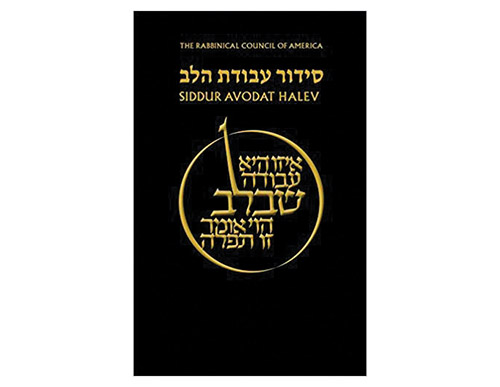
Reviewing: “Siddur Avodat HaLev,” by Rabbinical Council of America (Rabbi Basil Herring, editor). Koren Publishers Jerusalem. 2018. Hebrew/English edition. Hardcover. 1346 pages. ISBN-13: 978-9653019362.
The challenge of prayer is at once its tremendous power and its ubiquity, its frequency in your life. Pouring out your heart before the Creator with a fixed text three times a day quickly becomes an exercise in routine, as we all know. There is no easy solution to this problem.
A fixed text allows you to use the profound language of the greatest sages, who formulated our prayer with the proper order and utilized the most effective concepts and phrasings. But saying even the best prayer so often makes it difficult to concentrate on the all-too-familiar words, despite their importance. Many people have suggested strategies to improve your prayer and I have nothing to add to their recommendations. However, I see that the Sages who established the prayer texts foresaw this problem and attempted to reduce it. Paying attention to their strategy may help you pray better.
First, I wish to introduce a new prayer book, Siddur Avodat HaLev, published by the Rabbinical Council of America under the editorial guidance of Rav Basil Herring, the organization’s previous executive vice president. This Ashkenaz siddur contains a newly edited Hebrew text, a new English translation and an expansive new commentary. The Hebrew text is on the right page (as is familiar) in an easy-to-read font with specific vowels (sheva na and kamatz katan) emphasized for easy recognition. The Hebrew text has been carefully edited based on classical sources to reflect proper pronunciation, which will be lost on most users but still seems important to me—we want our prayers to reflect those of our great Sages in both big and small ways.
The siddur includes common Religious Zionist prayers that some synagogues say and others omit. It also includes a suggested text for a Holocaust memorial ceremony that I find extremely thoughtful—a chapter of Tehillim and then six Mishnayot to learn in memory of the six million deceased, one Mishnah from each of the six tractates, followed by Kaddish. The siddur also contains the full text of Tehillim with English translation.
I find the commentary most relevant to our discussion. This commentary, culled from dozens if not hundreds of sources and contributors (I contributed one comment on Pirkei Avot), explains the prayers, as expected, but also highlights the halachic significance of various passages. Some might consider this approach to be overly legalistic, as if Judaism consists merely of laws to occupy our thoughts and actions. I can imagine someone asking whether all the RCA expects of us is to follow the laws of prayer without actually praying. This objection misses the point of the laws of prayer.
The overall prayer structure has evolved over time, incorporating chapters from Tehillim and other passages in order to set the tone in advance of the most important prayers. Pesukei D’zimra builds up to the blessings of the Shema, which bracket the important biblical passages of the Shema and lead into the Amidah. Each of these sections, and others I have not mentioned, establish a mood of dependency, recognition and thankfulness. A meaningful Pesukei D’zimra leads to a powerful Amidah. The laws of prayer enable us to focus properly on the right prayers, recognizing their importance relative to each other and to other mitzvot that might arise during services. They help us understand the significance of the seasonal changes to the prayers, so that the prayers we recite are timely and reflect our needs, those of our community and the entire nation.
I remember as a child on Yom Kippur counting how many pages in the machzor remained until we could go home. It takes many hours for hundreds of pages to go by. As I aged, I understood the different sections of prayer—Shacharit, Kriat HaTorah, Musaf. The pages turn faster when each section is smaller. Later I learned the sub-sections, what happens during those prayers and what the texts mean. Now Yom Kippur seems short. Time flies when you are engaged with the prayers, when you understand the careful structure of the prayer services, when you find meaning in the words.
Siddur Avodat HaLev—in its commentary, halachic instructions accompanying the text, and additional essays in the back—teach readers what prayer is all about. They contain in-depth but accessible lessons on how prayer is structured, why we are saying this prayer here and that prayer there, and what those passages mean. From the very beginning—why do we say Modeh Ani on awakening and why do we say Al Netilat Yadayim and Elokai Neshama together?—to the end—why do we say Aleinu after each service?—the commentary quotes classical and new explanations for the meaning and order of prayers.
Often, these explanations share greater lessons. Just one example: “The fact that the congregation omits Tachanun whenever an individual in attendance is celebrating a personal simcha (such as a wedding or brit mila) or marking a sad occasion (such as shiva) is a remarkable and concrete halachic manifestation of the importance of sharing in our fellow Jews’ occasions of joy or sadness.” These comments, along with truly exceptional essays in the back about the laws, meaning, melodies and ideas of prayer, allow you to prepare for a better and more meaningful prayer. The Sages helped us improve our prayer by adding inspirational and meaningful passages to the text. Siddur Avodat HaLev is a tool which, when used effectively, can improve your prayers.
By Rabbi Gil Student
Rabbi Gil Student runs TorahMusings.com. His latest book is “Search Engine volume 2: Finding Meaning in Jewish Texts—Jewish Leadership.”











